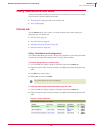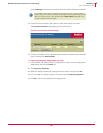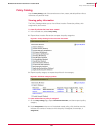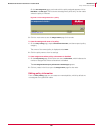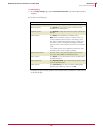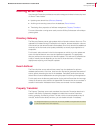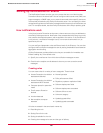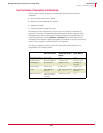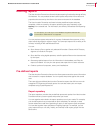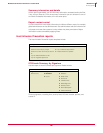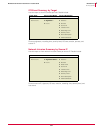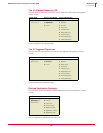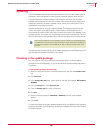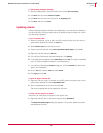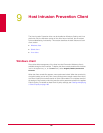
125
McAfee
®
Host Intrusion Prevention 6.1 Product Guide Maintenance
Running reports
8
Running reports
The Host Intrusion Prevention software includes reporting functionality through ePolicy
Orchestrator. You can produce several useful reports and queries from events and
properties that are sent by the client to the server and stored in the database.
The Host Intrusion Prevention software includes predefined report and query
templates, which are stored in the report repository and query repository under
Reporting in the console tree. For information, see ePolicy Orchestrator 3.6 Reporting
Guide.
You can produce reports and queries for a group of selected client systems, or limit
report results by product or system criteria. You can export reports into a variety of file
formats, including HTML and Microsoft Excel.
You can:
Set a directory filter to gather only selected information. Choose which Directory
segment to include in the report.
Set a data filter using logical operators, to define precise filters on the data returned
by the report.
Generate graphical reports from the information in the database, and filter the
reports as needed. You can print the reports and export them to other software.
Conduct queries of computers, events, and installations.
Pre-defined reports
The Host Intrusion Prevention clients on the client systems send the server information
that is stored in a reports database. You run reports and queries against this stored
data.
There are eight pre-defined Host Intrusion Prevention reports that fall into two main
categories: IPS reports and firewall reports.You can also create your own report
templates using Crystal Reports 8.5.
Report repository
The report repository contains the pre-defined reports and queries from Host Intrusion
Prevention and any custom reports and queries you create.
You can organize and maintain the report repository to suit your needs. For example,
you can add reports that you exported as report templates, for example, to save
custom selections made when generating a report, or add custom report templates.
You can also organize report templates in logical groupings. For example, you can
group reports that you run daily, weekly, and monthly under report groups with the
same name.
Note
To view reports, you must log on to the database using ePO credentials. NT
authentication credentials are not supported.



